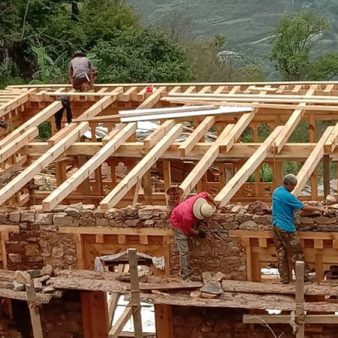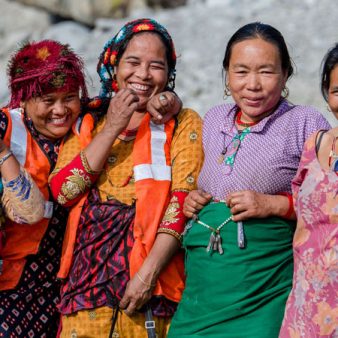To date the Ocean View Development Trust has assisted 700 poor and marginalised families to build and improve their own homes in one of the overcrowded Western Cape townships. Mutual aid and sweat equity help to reduce costs and workshops are used to develop and spread skills within the community. Innovative financing systems encourage the retention of wealth within the community, as well as creating jobs and a much improved living environment.
Project Description
Aims and Objectives
- To provide the poor and the marginalised members of the community not only with housing but also to enable them to take control of their own development.
- To create an environment whereby the community has access to various information and resources, such as skills development and community participation.
- To endorse the Bath Pele principles of “People First” and “Service Excellence” which centres on accountability, transparency, value for money, redress, honesty, integrity and respect.
The Ocean View Development Trust is a community-based organisation involved in a range of community development initiatives in the Ocean View area of Cape Town. It was established as a voluntary association in 1992 when representatives of 37 different community organisations came together to address the acute housing shortage in the area. For the past twelve years, OVDT has been involved in the development of a holistic and sustainable housing delivery strategy, where ‘housing’ provides impetus to economic growth, job creation, market creation, financial and credit viability and the provision of collateral. The Trust provides technical and training support for community self-help housing, promotes housing-related research and lobbies local, provincial and national government to support its ideas.
The Ocean View community was established in 1968 when individuals were forcibly removed from their original areas of residence under the terms of the Group Areas Act. The completed township was designed to provide housing for 1,800 families but today more than 30,000 residents live here. Overcrowding is a serious problem. One third of all houses accommodate more than one family. A single housing unit with a floor area of 45 m2 may be occupied by ten or more individuals. Secondary structures made of tin or temporary materials are often built on the plot and an average plot of 160m2 can house up to 20 individuals.
There are many social problems associated with the overcrowding and makeshift structures including poor health, domestic and child abuse and substance abuse. Up to 50 per cent of the population are unemployed and 75 per cent of residents earn less than $260 a month. Ocean View’s peripheral location and physical isolation from centres of economic activity have reinforced the problems of homelessness, poverty and high unemployment.
The key principle of the organisation is that local people should be at the centre of the development process and community development cannot be undertaken as a pre-determined programme by an external organisation. A concentric core dissemination strategy is used whereby effective communication is retained with the whole community. A community beneficiary committee is linked to housing clubs and street committees and through these to the whole community.
Financing has come from a range of sources including local and provincial government funds and national and international grant aid including USAID, Levi Strauss Foundation, Energos Foundation and Kagiso Trust. Projects will continue to be supported from national and international aid and possibly through a compact with a private sector developer working in the area.
The project is on-going and to date, has assisted 700 families and is looking to work with a further 2,500 poor and marginalised families. In total, 4,000 people have now been housed and now have access to clean water, sanitation, electricity and roads. There has been an overall improvement in health since the housing conditions in the area have improved.
A range of construction based jobs has also been created including masons, glaziers, carpenters, mechanics and welders. Training and empowerment workshops are held in conjunction with other development agencies and government departments. One formal pre-school and five home-based pre-schools have been established currently providing 300 children with pre-school education.
The project construction costs of $3.4 million were met by sweat equity/mutual aid $2.5 million and $900,000 from the provincial government and international aid USAID, Levi Strauss. Provision of infrastructure cost of $2 million was provided by local and provincial government and a local trust. Organisational support of $1.1 million was funded by provincial government and national and international aid.
OVDT contributes towards the development of housing policy at local and provincial levels. At provincial level it has contributed towards the development of the Provincial Housing Plan and works with local authority and community structures to advise on ‘People’s Housing’ delivery mechanisms in four other communities. The project has also served as a training module for 200 building and architectural students from local and international universities including Oxford Brookes, UK and University of Iowa, USA.
Why is it innovative?
- It is a model for effective housing delivery in low-income areas.
- Meaningful participation by the people directly affected in the design process and shaping of the development.
- The number of houses constructed.
- The amount of infrastructure provided (roads, sanitation, water supply).
- The extent of community empowerment.
- The number of jobs and small businesses created.
What is the environmental impact?
Cement blocks are used for construction and are sourced locally. Water and sanitation has been provided for 700 families to date. A further 2,500 connections are planned. This has resulted in improved local environment and the creation of cleaner spaces.
Is it financially sustainable?
External support will continue to be required to carry out the infrastructure and house construction work. It is anticipated that national and international donor agencies will provide running costs for the organisation and that South African government departments provide infrastructure and housing subsidies.
Partnership with a private developer is currently being explored, by which the developer will enter into a social compact with the community to establish a job creation joint venture with an agreement for 0.25 per cent of all sale proceeds, both on first and all subsequent sales, going to OVDT. This will generate a predicted annual income of $30,000 – $45,000.
Like all townships in the apartheid era, Ocean View had no infrastructure that would contribute towards its growth, capital retention and circulation. It is estimated that 80 per cent of disposable income leaves the community. This is being addressed through:
- Creation of local employment, building on a long tradition of artisan skills in the area.
- Creation of the Roll-Over Fund to help stimulate a natural local market. Building materials are produced locally and the community are encouraged to buy locally. 60 permanent jobs have been created plus other secondary jobs. The need for further work in this area is recognised.
- The development of Sparsa shops which are home-based shops that provide basic essentials and allow capital to be retained and circulated within the community.
- Developing building skills and facilitating a self-help/mutual aid process greatly reduce the cost of a house compared to construction by an outside private building firm. Family and friends often form housing clubs to work together to build their own homes, using the subsidy funds received from the national government. Community building teams have been established to help those who cannot build their own homes though the self-build process. Of the 700 houses built to date, 453 have used community builders or self-help methods; the remainder have employed non-community builders.
What is the social impact?
The project’s main purpose is to facilitate greater community cooperation and it uses a range of community workshops, education, training and networking methods to achieve this. It seeks to identify the wishes and aspirations of the community and to work together to develop plans of action.
The prevailing environment is one where male dominance takes precedence. Addressing the issue of gender equity is one of the key aspects of OVDT’s work. There has been a significant increase over the years in the number of women that are enquiring about, and participating in housing programmes.
Barriers
Lack of major longer-term funding to run the organisation is an ongoing problem.
Lessons Learned
- Sweat equity can be used as a community resource.
- It is important to develop a culture of savings to improve the financial viability of the local community.
- Community people should determine their own future through democratic processes and local leadership.
- Skills training, capacity building and community education are essential if local communities are to determine and solve their own problems.
- It is important to retain and circulate as much community disposable income as possible.
- Retaining skills and resources in the local community contributes towards its growth.
- Use of a multi-sectoral approach is more effective than addressing one specialised aspect of the development process.
- The establishment of common purpose housing clubs helps community members to help one another.
Evaluation
The Ocean View People’s Housing process has participated in a range of evaluations, including those by the national and provincial governments, USAID, a local academic and the People’s Housing Partnership Trust.
Transfer
This innovative approach to housing provision and community development forms part of the South African government’s housing strategy of the People’s Housing Process. OVDT has advised on the People’s Housing delivery mechanism in four housing projects in the province, covering a total of 2,100 homes. Many national and international visitors have come to see the project. These include government officials, CBOs and NGOs from Asia, Africa, Europe and America who see it as a model for housing delivery. The organisation has provided advice and support for a wide range of groups, including visitors from the Netherlands and the USA.
Partnership
NGO


